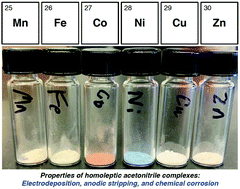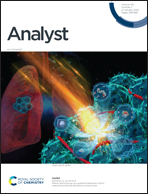Electrodeposition behavior of homoleptic transition metal acetonitrile complexes interrogated with piezoelectric gravimetry†
Abstract
Homoleptic acetonitrile complexes of first-row transition metal ions are a common product of the detrimental speciation of coordination complexes and organometallic compounds. However, the electrochemical properties of such species are mostly unknown, introducing ambiguities into interpretation of electroanalytical data associated with studies of molecular electrocatalysis. Here, we have cataloged the cyclic voltammetric properties of the solvento complexes of Mn(II), Fe(II), Co(II), Ni(II), Cu(I), and Zn(II) in acetonitrile electrolyte, providing information on the cathodic electrodeposition and anodic stripping processes occuring with each ion. The electrochemical quartz crystal microbalance (EQCM) has been used to quantify these processes, as well as the rates of the in situ corrosion of electrodeposited materials by the strong organic acid dimethylforamidinium, [DMFH]+. Ex situ X-ray photoelectron spectroscopic results confirm the interpretations of the voltammetric and gravimetric data, and confirm the periodic relationship between the metals. Taken together, the results described here provide an electrochemical roadmap useful in distinguishing currents arising from homogeneous electrocatalysis from currents associated with the redox cycling of secondary heterogeneous materials.

- This article is part of the themed collections: Versatile Electrochemical Approaches and Analyst Emerging Investigators


 Please wait while we load your content...
Please wait while we load your content...